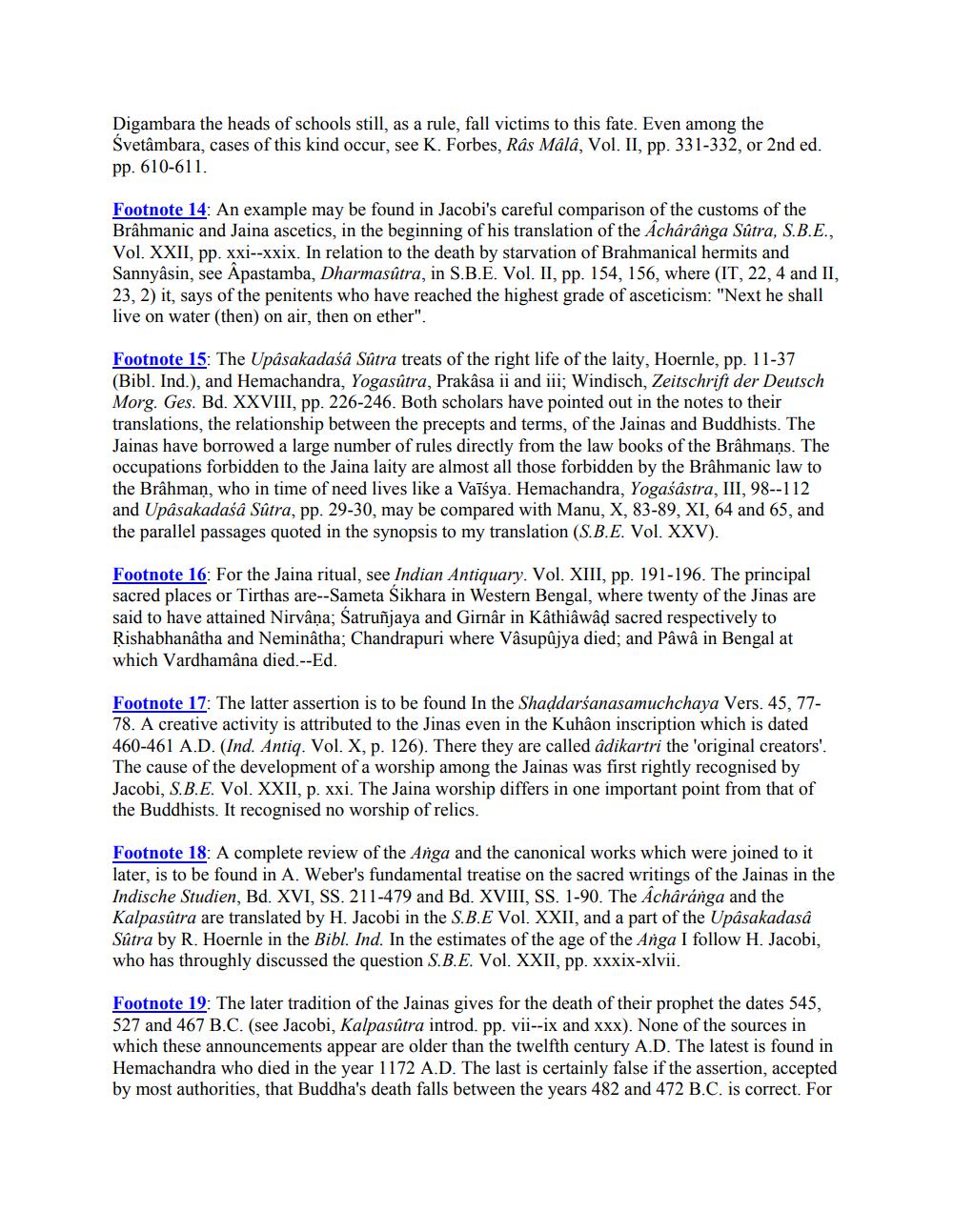________________
Digambara the heads of schools still, as a rule, fall victims to this fate. Even among the Svetâmbara, cases of this kind occur, see K. Forbes, Râs Mâlâ, Vol. II, pp. 331-332, or 2nd ed. pp. 610-611.
Footnote 14: An example may be found in Jacobi's careful comparison of the customs of the Brahmanic and Jaina ascetics, in the beginning of his translation of the Achârânga Sútra, S.B.E., Vol. XXII, pp. xxi--xxix. In relation to the death by starvation of Brahmanical hermits and Sannyâsin, see Apastamba, Dharmasútra, in S.B.E. Vol. II, pp. 154, 156, where (IT, 22, 4 and II, 23, 2) it, says of the penitents who have reached the highest grade of asceticism: "Next he shall live on water (then) on air, then on ether".
Footnote 15: The Upåsakadaśa Sútra treats of the right life of the laity, Hoernle, pp. 11-37 (Bibl. Ind.), and Hemachandra, Yogasútra, Prakasa ii and in; Windisch, Zeitschrift der Deutsch Morg. Ges. Bd. XXVIII, pp. 226-246. Both scholars have pointed out in the notes to their translations, the relationship between the precepts and terms, of the Jainas and Buddhists. The Jainas have borrowed a large number of rules directly from the law books of the Brāhmaṇs. The occupations forbidden to the Jaina laity are almost all those forbidden by the Brâhmanic law to the Brahman, who in time of need lives like a Vaīsya. Hemachandra, Yogasastra, III, 98--112 and Upåsakadaša Sútra, pp. 29-30, may be compared with Manu, X, 83-89, XI, 64 and 65, and the parallel passages quoted in the synopsis to my translation (S.B.E. Vol. XXV).
Footnote 16: For the Jaina ritual, see Indian Antiquary. Vol. XIII, pp. 191-196. The principal sacred places or Tirthas are--Sameta Sikhara in Western Bengal, where twenty of the Jinas are said to have attained Nirvana; Satruñjaya and Girnar in Kathiâwâd sacred respectively to Rishabhanatha and Neminâtha; Chandrapuri where Vâsupůjya died; and Pâwâ in Bengal at which Vardhamâna died.--Ed.
Footnote 17: The latter assertion is to be found in the Shaddarśanasamuchchaya Vers. 45, 7778. A creative activity is attributed to the Jinas even in the Kuhâon inscription which is dated 460-461 A.D. (Ind. Antiq. Vol. X, p. 126). There they are called âdikartri the original creators'. The cause of the development of a worship among the Jainas was first rightly recognised by Jacobi, S.B.E. Vol. XXII, p. xxi. The Jaina worship differs in one important point from that of the Buddhists. It recognised no worship of relics.
Footnote 18: A complete review of the Anga and the canonical works which were joined to it later, is to be found in A. Weber's fundamental treatise on the sacred writings of the Jainas in the Indische Studien, Bd. XVI, SS. 211-479 and Bd. XVIII, SS. 1-90. The Achâránga and the Kalpasútra are translated by H. Jacobi in the S.B.E Vol. XXII, and a part of the Upâsakadasa Sútra by R. Hoernle in the Bibl. Ind. In the estimates of the age of the Anga I follow H. Jacobi, who has throughly discussed the question S.B.E. Vol. XXII, pp. xxxix-xlvii.
Footnote 19: The later tradition of the Jainas gives for the death of their prophet the dates 545, 527 and 467 B.C. (see Jacobi, Kalpasútra introd. pp. vii--ix and xxx). None of the sources in which these announcements appear are older than the twelfth century A.D. The latest is found in Hemachandra who died in the year 1172 A.D. The last is certainly false if the assertion, accepted by most authorities, that Buddha's death falls between the years 482 and 472 B.C. is correct. For




